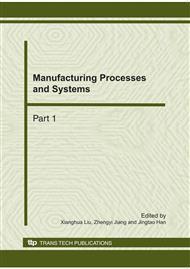p.586
p.590
p.595
p.601
p.606
p.611
p.615
p.621
p.628
Effect of Incident Angle on Laser Transformation Hardening Layer Microstructure and Properties
Abstract:
Laser transformation hardening was carried out by HL-1500 CO2 laser on 40Cr steel. The macroscopic and properties were analysised by scanning electron microscope, X-ray diffractometer, microhardness meter and potentiostat. The result indicated that, the hardening layer is mainly constitute by Fe-Cr, C0.09Fe1.91, Fe2Si. After laser transformation hardening the hardness enhanced greatly, the maximum of hardness appears in the subsurface, which value is as about four times as that of the substrate, both wear resistance and corrosion resistance are improved. With the increase of the laser incident angle, microstructure’s inhomogeneity becomes larger, properties become decreased.
Info:
Periodical:
Pages:
606-610
Citation:
Online since:
October 2010
Authors:
Price:
Сopyright:
© 2011 Trans Tech Publications Ltd. All Rights Reserved
Share:
Citation:


